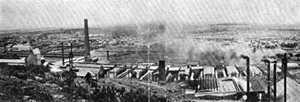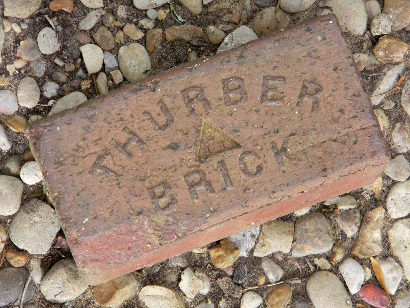|
|
There
never was a Texas town quite like Thurber
and there never will be again. In a state not known for coal, Thurber
produced tons of "black diamonds" for more than 30 years. In a state
known for its independence, Thurber
was a wholly company-owned town, right down to the last nail in
the last miner's house, and became a union town populated by mostly
foreign workers.
Thurber,
along with Indianola,
is perhaps the state's most celebrated ghost town because it was
contrary to ordinary in every way. Situated in the northeast corner
of Erath County,
almost to the Palo
Pinto County line, Thurber
was different from every other Texas town of its time. This was
not a land of cotton or cattle
but of coal, bricks and, later oil. Thurber
was one of the first towns in the state to have full electric service
and its ice factory, with a 17-ton capacity, was the largest in
the Southwest. There was even an opera house. A.C. Greene in his
book "A Personal Country" wrote that Thurber
had "a kind of dangerous pretension."
"Thurber
was a mining town, an industrial city, and a true city, while most
of the rest of West Texas
burned cow chips for fuel and gathered buffalo bones to sell to
survive the droughts," Greene wrote. "While other towns in West
Texas considered the buckboard and the buggy the ultimate in
transportation, Thurber
had a siding for the Pullman Palace cars and private sleepers which
were set off the mainline Texas and Pacific Railway at Mingus
for the short ramble down to Thurber's
station on the town square."
Only company miners, along with some school teachers and preachers,
were allowed to live in Thurber,
and the miners were a diverse group that representing some 18 or
so ethnic groups. Italians made up more than half of the work force
with Poles representing about 12 percent. Others came from Britain,
Ireland, Mexico, Germany, France, Belgium, Austria, and Sweden and
from coal mining regions of the U.S. Early attempts to unionize
the workers failed, but the United Mine Workers union was formed
in 1903. A second union, the Italian local, followed in 1906. Thurber
became the only 100 percent closed shop nation in the country.
A land speculator from Michigan, William Whipple Johnson, discovered
coal in the area in the 1880s and began mining operations but, following
a strike by the miners, sold the company to a group of eastern investors
who formed the Texas and Pacific Coal Company. A contract with the
Texas & Pacific Railway, originally negotiated by Johnson, was renegotiated
and a new town named for T&P investor H.K. Thurber
was built. By the turn of the century, Thurber was the leading coal-producing
area in the state and Texas' coal output exceeded the value of all
other minerals combined.
|
 |
The Thurber Brick
yards.
TE Post Card Archives |
The 1908 smokestack
in Thurber
Photo courtesy TXDoT |
The area that
produced the Texas coal also had a large amount of shale clay, which
the glad hands of Thurber
industry used to produce bricks. Practically the entire town was made
of brick. "All its streets and sidewalks, its smokestack and pumphouses,
the bandstand on the square, railroad abutments, bridges and watering
troughs - all were made of brick," Greene wrote.
In the course of looking for coal and other mineral deposits, mine
manager William Knox Gordon became convinced that the area west of
town contained significant amounts of coal and gas. Trained geologists
disagreed, but when Gordon hit oil a few miles from Thurber,
near Strawn, the company
okayed continued exploration. That led to the discovery of the wildly
productive Ranger oil field in October of 1917 and the beginning of
an oil boom that changed everything, including Thurber. |
 |
|
Thurber
initially prospered from the local oil boom. The company added "and
Oil" to its name but when locomotives converted from coal-fired
steam engines to oil burners, Thurber
had no market for its coal. To make up for the loss of the coal
market, Thurber
began producing paving bricks, which are about twice as heavy as
an ordinary brick. Thurber bricks paved many Texas highways and
streets, including Congress Avenue in downtown Austin,
and were used to construct the Galveston
Sea Wall, the Bankhead Highway, Camp Bowie and the Fort Worth
Stockyards. Then along came concrete and asphalt roads and the market
for the paving bricks went the way of coal-fired steam engines.
In 1933, in the middle of the Great Depression, the company announced
that the town was being abandoned. The utility poles were taken
down and the wire was salvaged. The houses were boarded up and supplies
were sold at cost in the company store. In a blink, it was gone.
"Thurber
had been built all at once, its population had come all at once,
and everything it did all at once," Greene wrote. "And as things
turned out, it died all at once."
© Clay Coppedge
November 1, 2014 Column
More "Letters from Central Texas"
|
|
|
